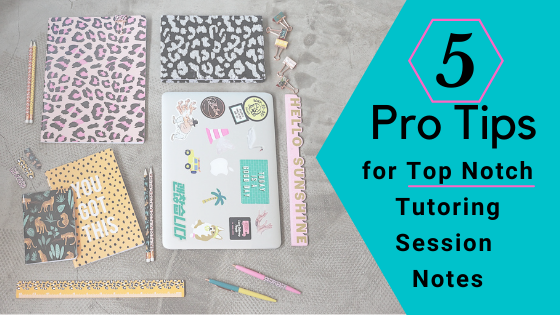5 Pro Tips for Top-Notch Tutoring Session Notes
Reflection is a cornerstone of effective education. That may sound really lofty, but it’s true. As a tutor, you must be constantly looking back at your efforts to find areas where both you and your students can grow. Taking high-quality notes for each tutoring session helps to both streamline that process and make reflection a habit.
But that’s not all. From a practical standpoint, keeping purposeful, high-quality notes for your tutoring sessions can improve your practice in a variety of other ways as well.
Effective tutoring session notes should:
provide anecdotal records (including times, dates, locations, and payments) to document services rendered
keep track of what content is covered each session
document a student’s questions
record the materials used during the session
assess which teaching strategies are most effective for a particular client
list any goals or objectives that were established
Good tutoring session notes require some deliberate focus, but they don’t have to be a stressor or even a huge time investment. Planning is the key.
Here are 5 key ways that you can make sure your note taking workflow is the perfect mix of comprehensive and hassle-free:
1. Make (or “borrow”) a template.
A running record of the essential information from a tutoring session can get real messy, real fast. The whole purpose of note taking is to create a resource that is both organized and useful. Streamline your process by making a template.
Create dedicated space for each of the crucial elements listed above and you will wind up with a great session-by-session log of your work with each client.
If you are technologically savvy, consider using a web-based publishing option like a Google Doc or Google Sheet that can follow you anywhere and on any device (as long as you can get online!).
2. Focus on the “How” and not just the “What.”
When taking notes on a tutoring session, it can be easy to focus solely on the content. What was covered? What was asked? What was assigned?
What separates elite tutors from the pack is their ability to reflect upon how content is delivered most effectively.
Pay attention to the strategies, methods, and inroads you use when tutoring clients. Note which are effective and lead to those “a-ha!” moments. These strategies will likely prove to be effective again down the road when working on future content. Not only that, these insights can help parents and teachers support the student in between sessions.
Successes aren’t the only elements of your instructional practice you should be reflecting upon. Make note of strategies that flat-out do not work with a particular client - particularly ones that lead to obvious confusion or irritation. Tutoring can be challenging in the best of times, ignoring patterns of frustration will only make things tougher. Good notes can help you identify those patterns more easily.
3. Jot down key details throughout the session.
You can drastically cut down on both forgetfulness and your time investment by making note taking part of your tutoring-session routine. Creating a simple form makes it easy to keep your thoughts organized on the fly and will make finalizing your session notes that much simpler.
If you’ve recorded key details throughout the session, you’ll be sure to have what you need to document the session and plan for the future – regardless of whether you use time after the session to simply fill in the gaps or opt to rewrite the notes wholesale.
4. Finalize your notes as soon after the session as possible.
Many tutors wait until the end of their day to record their session notes. After all, it can be difficult to find the time for written records and reflections when the next client is looming.
The problem is, waiting to write your session notes increases the chance that you will forget a key detail from the session. Often, it is a little thing - a frustration, a question, a mistake, or an example – that becomes the basis for a breakthrough. Even with note taking during each session, a lost detail may wind up being the crucial one for establishing a pathway to growth.
Instead of putting off finishing your tutoring-session notes, schedule time between each session to take care of them.
5. Tutoring session notes are not progress reports.
It is important to distinguish between tutoring-session notes for you and the progress reports that you share with your clients (or your clients’ parents).
The best tutors share as much insight and information as they can with clients following their sessions. That said, your session notes will be more authentic and valuable as reflective tools if you are writing them with yourself as the intended audience.
This removes the extra burden of trying to get notes perfectly and cleanly on the spot. It can also save you from handing something over to a client that is sloppy, filled with errors, or otherwise casts you in an unprofessional light.
Definitely use your notes to flesh-out client progress reports, but give them a solid proofread and revision before sharing in a final form. While Clear Choice Prep’s state-of-the-art software can provide parents and students with automated progress reports on the spot, set the expectation that any anecdotal supporting materials will be sent after the session, just not immediately after the session. Your quality feedback and insights will be worth the wait!
Want to know more about how Clear Choice Prep can help you be a more efficient and effective tutor? Subscribe to our blog and never miss our latest tips or a new, free tool!


